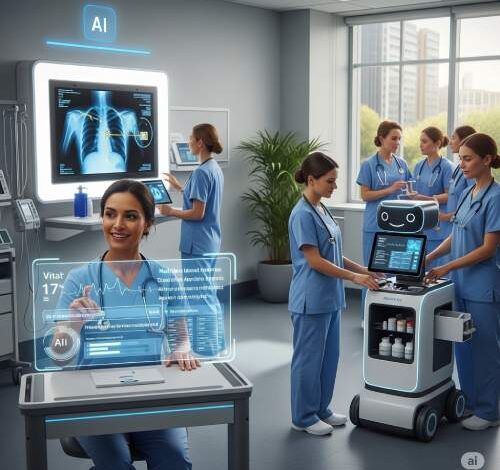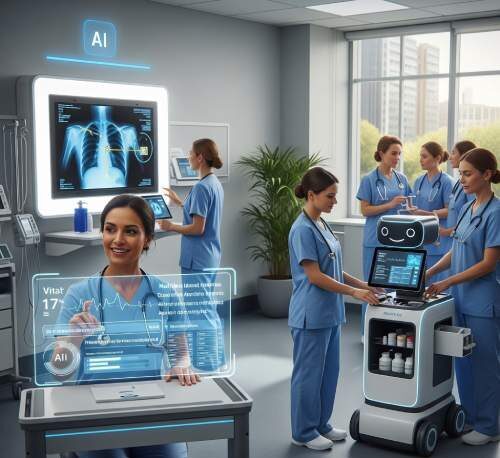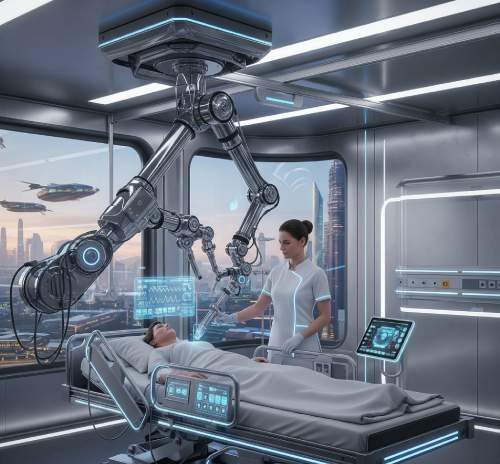AI Made Easy: The Ultimate AI Nursing Documentation Guide (2025)

AI Made Easy: The Ultimate AI Nursing Documentation Guide (2025)
In today’s fast-paced healthcare system, accurate and timely documentation can make the difference between smooth patient care and overwhelming burnout for nurses. That’s where artificial intelligence steps in. This AI Nursing Documentation Guide for 2025 breaks down everything nurses, nurse educators, and healthcare leaders need to know about using AI to simplify charting, reduce paperwork, and improve patient outcomes.

Whether you’re an RN, LPN, or nurse practitioner, this guide explains how AI-powered tools can take the stress out of documentation—making your job easier, more efficient, and more rewarding.
Artificial intelligence is no longer a futuristic concept reserved for tech companies—it’s becoming a practical, everyday solution in hospitals, clinics, and long-term care facilities. From automated charting systems that capture patient notes in real time, to predictive AI that flags potential risks in a patient’s history, nursing documentation is transforming at lightning speed. In this AI Nursing Documentation Guide, you’ll discover how AI streamlines workflows, cuts down on errors, and gives you back more time for hands-on patient care—the part of nursing that matters most.
This guide also addresses common concerns nurses may have: Is AI safe and HIPAA-compliant? Will it replace nurses? How do I get started with AI documentation software in 2025? By the end of this article, you’ll have clear, step-by-step insights into the best AI tools, practical use cases, benefits, and limitations of integrating AI into your documentation routine.
Whether you’re new to artificial intelligence or already exploring advanced nursing tech, this AI Nursing Documentation Guide is your go-to resource for mastering AI in healthcare documentation. If your goal is to reduce charting fatigue, improve accuracy, and deliver better care, then this guide will show you exactly how AI can help you achieve it in 2025 and beyond.
Why Nurses Need an AI Nursing Documentation Guide in 2025
Nursing documentation has always been one of the most time-consuming tasks in healthcare. Between electronic health records (EHRs), patient progress notes, medication logs, and compliance reports, nurses often spend more hours on documentation than on direct patient care.

That’s where this AI Nursing Documentation Guide becomes essential. By using AI-powered tools in 2025, nurses can dramatically reduce documentation time while improving accuracy and compliance.
Here are the key reasons why AI in nursing documentation is transforming the profession:
-
Time-Saving Efficiency – AI-assisted charting captures spoken notes, organizes them, and inputs them directly into the EHR, cutting documentation time by up to 50%.
-
Fewer Errors – AI reduces the risk of missing details, misinterpretations, or manual input mistakes, ensuring better accuracy in patient records.
-
Improved Patient Care – With less time spent on paperwork, nurses can focus on direct care, building stronger patient relationships.
-
Smart Alerts & Insights – AI can detect patterns, highlight abnormal results, and flag potential risks, supporting early interventions and better outcomes.
-
Burnout Reduction – By taking over repetitive charting tasks, AI helps lower stress levels and prevents documentation fatigue.
This section of the AI Nursing Documentation Guide makes it clear: adopting AI is not about replacing nurses—it’s about empowering them to work smarter, safer, and with more time for the human side of nursing.
Easy Opportunity: Top Travel Nursing Agencies in the US Hiring in 2025
Top AI Tools for Nursing Documentation in 2025
No AI Nursing Documentation Guide would be complete without a look at the best tools that are changing the way nurses document care. In 2025, AI-driven platforms are designed not just for efficiency, but also for compliance, safety, and usability across different healthcare settings. Whether you’re in a hospital, long-term care facility, or community clinic, these tools are making documentation easier and more accurate.
1. AI-Powered Charting Assistants
These tools listen to nurse-patient interactions in real time and automatically generate structured clinical notes. They integrate directly with EHR systems, reducing the need for manual typing and double-checking.
2. Voice-to-Text Documentation Software
Modern speech recognition software, enhanced by AI, captures verbal notes instantly and adapts to medical terminology. Nurses can document on the go—hands-free and error-free.
3. Smart EHR Integrations
Some EHRs now come with built-in AI modules that auto-populate fields, suggest care plans, and ensure compliance with charting requirements, saving hours per shift.
4. Predictive Analytics Tools
Beyond documentation, AI tools analyze charted data to highlight early warning signs, medication risks, or potential complications—giving nurses actionable insights for better decision-making.
5. Mobile AI Nursing Apps
For nurses on the move, mobile-friendly AI documentation apps provide quick, secure ways to chart patient notes at the bedside or during home visits.
By including these tools in your workflow, this AI Nursing Documentation Guide shows you how technology can act as a supportive partner rather than an added burden.
Ultimate Guide: Travel Nurse Salary vs Staff Nurse Salary 2025 – What Pays More ?(Easy route)
Step-by-Step: How to Implement AI in Nursing Documentation
Adopting AI doesn’t have to feel overwhelming. The goal of this AI Nursing Documentation Guide is to make the process simple and practical for every nurse, regardless of technical experience.

By following a clear plan, you can smoothly integrate AI documentation tools into your daily routine.
Step 1: Assess Your Documentation Needs
Start by identifying your biggest pain points—whether it’s lengthy charting, frequent errors, or time lost on repetitive tasks. Knowing your priorities helps you select the right AI solution.
Step 2: Choose the Right AI Tool
Not every system is built for every healthcare environment. Hospital nurses may need an AI-powered EHR integration, while community or home health nurses may benefit more from mobile AI documentation apps.
Step 3: Ensure Compliance & Security
Before adopting AI, confirm that the tool is HIPAA-compliant and aligns with your facility’s privacy regulations. Patient data security should always come first.
Step 4: Train and Adapt
Like any new system, AI requires adjustment. Most platforms offer onboarding sessions and ongoing support. Take time to practice, explore features, and get comfortable using the software.
Step 5: Integrate AI into Your Workflow
Begin by using AI for simple documentation tasks such as progress notes or shift reports. Once confident, expand its use to more complex charting. Gradual adoption prevents overwhelm and builds trust in the system.
Step 6: Monitor Results and Improve
Regularly evaluate how AI impacts your workflow. Are you saving time? Are errors reduced? Use these insights to fine-tune your use of the tool and maximize benefits.
By following these steps, this AI Nursing Documentation Guide ensures that nurses transition smoothly into using AI—gaining efficiency without sacrificing accuracy or patient care quality.
💰 Average Nurse Salary in USA (2025) – State-by-State Guide: How Much Nurses Really Make
Challenges and Limitations of AI in Nursing Documentation
While this AI Nursing Documentation Guide highlights the many advantages of artificial intelligence, it’s also important to understand the challenges. AI can streamline workflows and improve accuracy, but it isn’t perfect—and being aware of its limitations helps nurses use it wisely.
1. Learning Curve for Nurses
AI-powered systems often require training. Nurses who aren’t familiar with digital documentation may feel overwhelmed at first, leading to slower adoption.
2. Cost and Accessibility
Advanced AI documentation tools can be expensive to implement, especially for smaller healthcare facilities or those in resource-limited settings.
3. Data Privacy Concerns
Since AI systems process sensitive patient data, any breach could have serious consequences. Strict adherence to HIPAA and data security protocols is non-negotiable.
4. Overreliance on Technology
If nurses rely too heavily on AI, critical thinking and observational skills may decline over time. AI should support nursing judgment, not replace it.
5. Integration Issues
Not all AI systems integrate smoothly with existing EHRs or hospital IT infrastructure, creating workflow disruptions if not carefully planned.
6. Ethical and Legal Questions
When AI makes clinical suggestions or flags risks, who is ultimately responsible—the nurse or the software? These gray areas are still being debated in healthcare law and ethics.
Despite these challenges, the benefits often outweigh the drawbacks when AI is implemented thoughtfully. The key takeaway from this AI Nursing Documentation Guide is that technology works best as a partner—supporting nurses rather than replacing them.
Proven Guide: State Boards Accepting Foreign-Educated Nurses for the NCLEX 2025
The Future of AI in Nursing Documentation (2025 and Beyond)
As this AI Nursing Documentation Guide shows, artificial intelligence is already reshaping how nurses manage patient records. But what lies ahead promises even more innovation.

In the coming years, AI will move beyond simple charting assistance to become a fully integrated partner in patient care.
1. Seamless EHR Integration
Future AI tools will work across all electronic health record platforms, eliminating compatibility issues and creating a unified documentation system that follows patients across different facilities.
2. Predictive and Preventive Care
AI won’t just document what’s happening—it will analyze real-time data to predict potential complications, medication interactions, and patient deterioration, giving nurses the chance to act earlier.
3. Smarter Voice and Ambient Technology
Charting may soon become completely hands-free. AI-driven ambient listening systems will automatically capture conversations and translate them into structured, HIPAA-compliant patient notes.
4. Personalized Nursing Workflows
Future AI documentation systems will adapt to a nurse’s specific role, specialty, and workflow. For example, ICU nurses may get advanced monitoring insights, while community nurses may see simplified, mobile-first documentation.
5. Global Adoption and Standardization
By 2030, AI documentation tools are likely to become global standards, helping countries with nursing shortages streamline care and reduce administrative burdens.
The future of AI in nursing documentation is not about replacing human judgment—it’s about freeing nurses from the weight of paperwork so they can focus on what matters most: compassionate, high-quality patient care. This AI Nursing Documentation Guide is just the beginning of that journey.
Conclusion: Making Nursing Documentation Easier with AI
This AI Nursing Documentation Guide demonstrates that artificial intelligence is no longer just a futuristic buzzword—it’s a real, practical solution transforming the nursing profession today. In 2025, AI is empowering nurses by simplifying charting, minimizing errors, reducing administrative burdens, and freeing up more time for what matters most—direct patient care. Instead of spending hours buried in documentation, nurses can now focus on building stronger patient relationships, improving care outcomes, and reducing the risk of burnout.
Of course, challenges remain. Costs, data security, ethical considerations, and training requirements cannot be ignored. Yet, when weighed against the benefits—time savings, improved accuracy, enhanced patient safety, and reduced stress—the advantages of AI far outweigh the drawbacks. Responsible implementation, guided by proper training and strong privacy safeguards, ensures that AI becomes a reliable partner rather than a source of concern.
For nurses, the message is both reassuring and inspiring: AI is not here to replace you—it is here to support you. It automates the repetitive, time-consuming parts of documentation while leaving clinical judgment, critical thinking, and compassionate care firmly in the hands of nurses. By embracing AI-driven tools, following best practices, and staying adaptable in this rapidly evolving healthcare environment, nurses can transform documentation from a daily challenge into a streamlined, efficient process.
The future of nursing documentation is smart, efficient, and nurse-centered. AI will continue to evolve, integrating more seamlessly with electronic health records, offering predictive insights, and creating personalized workflows for different nursing specialties. Nurses who adopt these innovations early will not only ease their workload but also set the standard for the next generation of healthcare.
In short, this AI Nursing Documentation Guide proves one thing: the future of nursing documentation is already here—and it’s built on the powerful partnership between nurses and AI. Together, they’re shaping a healthcare system that is faster, safer, and more patient-focused than ever before.
Resources and References
To ensure this AI Nursing Documentation Guide is accurate, reliable, and up to date for 2025, we’ve pulled insights from trusted healthcare, nursing, and technology sources. If you’d like to explore further, here are some valuable references:
-
American Nurses Association (ANA) – Official updates on nursing practice and technology adoption.
👉 https://www.nursingworld.org -
National Library of Medicine (PubMed) – Peer-reviewed research on AI in healthcare and nursing documentation.
👉https://pubmed.ncbi.nlm.nih.gov -
HealthIT.gov – U.S. government resource on electronic health records and health IT standards.
👉 https://www.healthit.gov -
HIPAA Journal – Guidance on AI, patient privacy, and data security compliance.
👉 https://www.hipaajournal.com -
Journal of Nursing Administration (JONA) – Research on nursing efficiency, burnout, and technology integration.
👉https://journals.lww.com/jonajournal -
Nuance DAX – AI-powered clinical documentation tool.
👉 https://www.nuance.com/healthcare/dragon-medical/dax.html -
DeepScribe – AI medical scribe for clinical documentation.
👉 https://www.deepscribe.ai -
Augmedix – Ambient AI documentation for healthcare providers.
👉 https://www.augmedix.com
By combining evidence-based research with real-world nursing insights, this AI Nursing Documentation Guide gives you a practical, trustworthy, and forward-looking roadmap for integrating AI into your nursing practice.
Frequently Asked Questions (FAQs) on AI Nursing Documentation Guide
An AI Nursing Documentation Guide is a resource that explains how artificial intelligence can simplify the charting process for nurses. It covers tools, benefits, challenges, and practical steps for implementing AI into daily documentation routines in 2025 and beyond.
AI reduces charting time by automatically generating patient notes, suggesting clinical details, and integrating with electronic health records (EHRs). This allows nurses to spend less time typing and more time on direct patient care.
No. AI is designed to assist nurses, not replace them. While it can automate repetitive tasks like note-taking, voice-to-text input, and form filling, nurses remain responsible for clinical judgment, decision-making, and patient interaction.
On average, AI can cut documentation time by 30–50%, depending on the tool and setting.
Yes. Many affordable mobile apps and lightweight AI systems are designed for small practices, community clinics, and home health care.
AI will continue to evolve toward predictive analytics, real-time risk detection, and fully automated documentation, giving nurses more time for direct patient care.
Some challenges include training and learning curves, high implementation costs, integration with existing EHR systems, and concerns about overreliance on technology. These are addressed in this AI Nursing Documentation Guide to help nurses adopt AI effectively.
When used correctly, AI can significantly reduce burnout by minimizing repetitive documentation tasks and cutting down after-shift charting. However, poor implementation without proper training may temporarily cause frustration.
Yes. Many mobile-friendly and cloud-based AI apps are designed specifically for smaller healthcare facilities, outpatient clinics, and home health nurses. They are affordable, easy to implement, and secure.
By ensuring accuracy, reducing errors, and providing predictive insights (such as early warnings for complications), AI documentation tools indirectly improve patient outcomes while allowing nurses to spend more time in direct care.





3 Comments